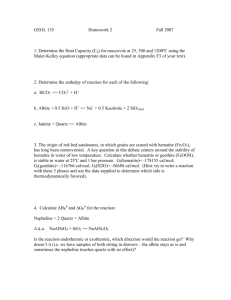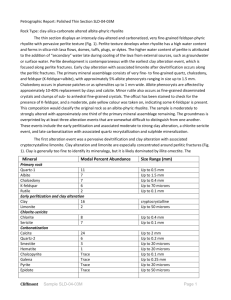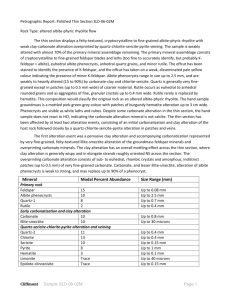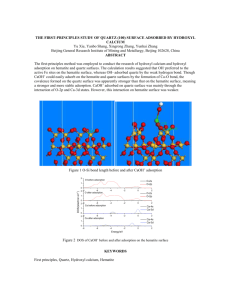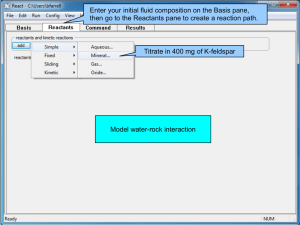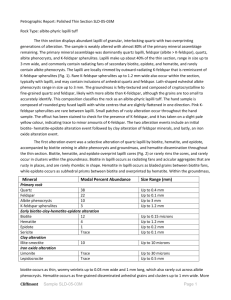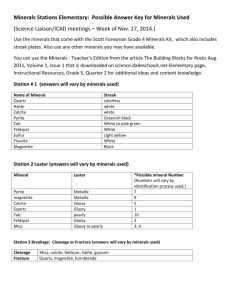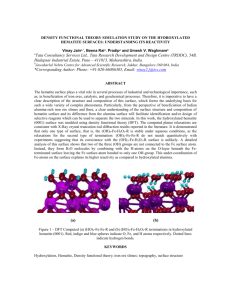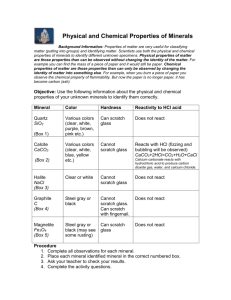SLD-03-01MB psm
advertisement
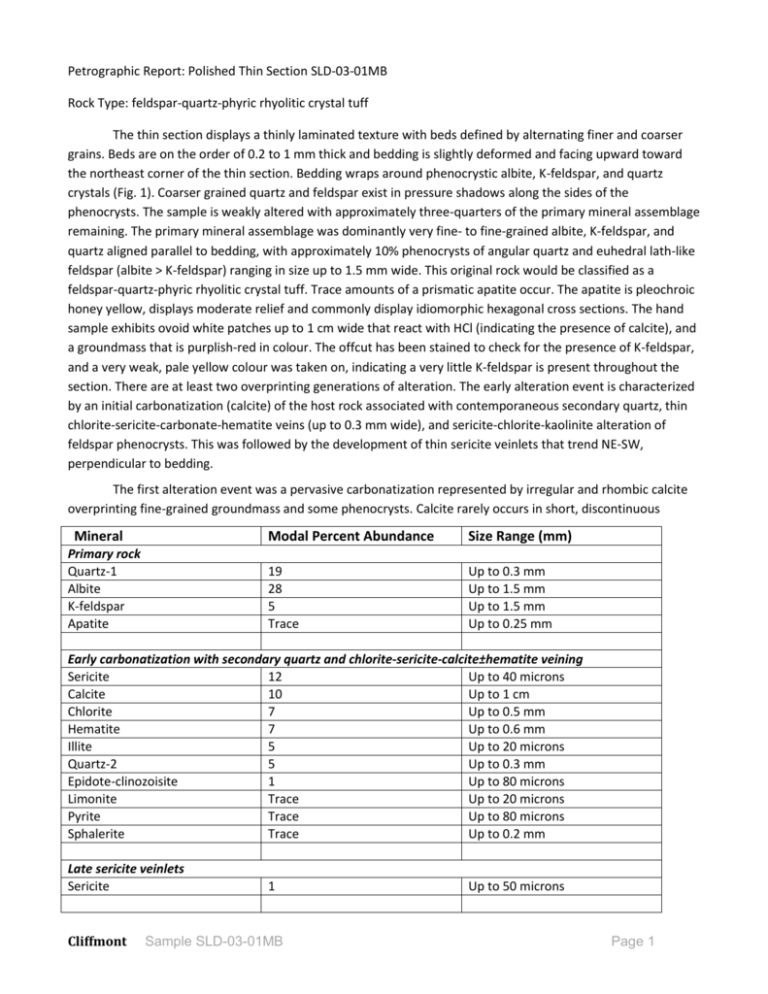
Petrographic Report: Polished Thin Section SLD-03-01MB Rock Type: feldspar-quartz-phyric rhyolitic crystal tuff The thin section displays a thinly laminated texture with beds defined by alternating finer and coarser grains. Beds are on the order of 0.2 to 1 mm thick and bedding is slightly deformed and facing upward toward the northeast corner of the thin section. Bedding wraps around phenocrystic albite, K-feldspar, and quartz crystals (Fig. 1). Coarser grained quartz and feldspar exist in pressure shadows along the sides of the phenocrysts. The sample is weakly altered with approximately three-quarters of the primary mineral assemblage remaining. The primary mineral assemblage was dominantly very fine- to fine-grained albite, K-feldspar, and quartz aligned parallel to bedding, with approximately 10% phenocrysts of angular quartz and euhedral lath-like feldspar (albite > K-feldspar) ranging in size up to 1.5 mm wide. This original rock would be classified as a feldspar-quartz-phyric rhyolitic crystal tuff. Trace amounts of a prismatic apatite occur. The apatite is pleochroic honey yellow, displays moderate relief and commonly display idiomorphic hexagonal cross sections. The hand sample exhibits ovoid white patches up to 1 cm wide that react with HCl (indicating the presence of calcite), and a groundmass that is purplish-red in colour. The offcut has been stained to check for the presence of K-feldspar, and a very weak, pale yellow colour was taken on, indicating a very little K-feldspar is present throughout the section. There are at least two overprinting generations of alteration. The early alteration event is characterized by an initial carbonatization (calcite) of the host rock associated with contemporaneous secondary quartz, thin chlorite-sericite-carbonate-hematite veins (up to 0.3 mm wide), and sericite-chlorite-kaolinite alteration of feldspar phenocrysts. This was followed by the development of thin sericite veinlets that trend NE-SW, perpendicular to bedding. The first alteration event was a pervasive carbonatization represented by irregular and rhombic calcite overprinting fine-grained groundmass and some phenocrysts. Calcite rarely occurs in short, discontinuous Mineral Primary rock Quartz-1 Albite K-feldspar Apatite Modal Percent Abundance Size Range (mm) 19 28 5 Trace Up to 0.3 mm Up to 1.5 mm Up to 1.5 mm Up to 0.25 mm Early carbonatization with secondary quartz and chlorite-sericite-calcite±hematite veining Sericite 12 Up to 40 microns Calcite 10 Up to 1 cm Chlorite 7 Up to 0.5 mm Hematite 7 Up to 0.6 mm Illite 5 Up to 20 microns Quartz-2 5 Up to 0.3 mm Epidote-clinozoisite 1 Up to 80 microns Limonite Trace Up to 20 microns Pyrite Trace Up to 80 microns Sphalerite Trace Up to 0.2 mm Late sericite veinlets Sericite Cliffmont 1 Sample SLD-03-01MB Up to 50 microns Page 1 veinlets up to 0.5 mm wide that are oriented perpendicular to bedding. Carbonate also occurs in ovoid patches of coarse calcite up to 1 cm wide. Calcite is in some places rimmed by contemporaneous coarse-grained secondary quartz and occasionally has chlorite-sericite-calcite-hematite veins wrapping between the calcite and secondary quartz (Fig. 2). Chlorite-sericite-calcite-hematite veins are also randomly oriented across the thin section with a vein density of about 5%. Chlorite dominates the mineralogy of these veins. The veins intersect themselves and have an enterolithic texture due to N-S direction flattening of the host rock (Fig. 1). In some places, these veins dissipate into thin, straight hematite veinlets trending NE-SW. Albite and K-feldspar phenocrysts are heavily altered (between 40 to 100% of the crystals) to sericite (dominantly), calcite, chlorite, and minor hematite and illite. Trace amounts of epidote-clinozoisite, pyrite, and sphalerite (Fig. 3) also occur in heavily altered phenocrysts, and are particularly associated with chlorite. A single grain of sphalerite found in a calcite-sericite altered albite phenocryst exhibits moderate chalcopyrite disease. This phenocryst replacement is likely contemporaneous with carbonatization and veining. Hematite also occurs as fine, anhedral grains and masses/knots disseminated throughout the groundmass of the thin section, and is coarser in coarser-grained beds. Pyrite is closely associated with hematite knots, and is probably replaced by hematite. The alteration mineral assemblage here is consistent with the propylitic alteration assemblage. The second alteration consists of very thin, straight sericite veinlets trending NE-SW overprinting groundmass quartz and feldspar and chlorite-calcite-sericite±hematite veins. The sericite veins post-date the chlorite-dominant veins since they are undeformed (Fig. 1). vn chl-srct cal srct-2 ab qtz cal ab hem Figure 1: Photomicrograph of deformed bedding wrapping around an albite (ab) phenocryst. Bedding faces upward towards the northeast. Albite is heavily altered to chlorite, sericite, and carbonate. Very thin veinlets of sericite (srct-2) are undeformed and discordant to bedding. Photo taken in plane polarized transmitted light. Cliffmont Sample SLD-03-01MB hem Figure 2: Photomicrograph of a patch of irregular calcite (cal) rimmed by secondary quartz (qtz). A thin chlorite-sericite-calcite-hematite vein (vn) winds its way between the calcite and quartz. An albite (ab) phenocryst is heavily replaced by calcite and sericite. Photo taken in cross polarized transmitted light. Page 2 Figure 3: Photomicrograph of a heavily calcite-sericite altered albite phenocryst containing a single grain of sphalerite (sph) with chalcopyrite disease associated with a small, subrounded pyrite. Photo taken in cross polarized transmitted and reflected light. py sph cal cal-srct Cliffmont Sample SLD-03-01MB Page 3
